
Colombo, Parisian, Larraburu. These bakeries produced the bread that made “San Francisco Sourdough” unarguably the most iconic bread produced in America. They are all gone now, and while San Francisco is still (again?) home to some amazingly delicious sourdough breads, the only place to get that old-style San Francisco Sourdough bread is at the Tadich Grill restaurant. Theirs is especially made by Boudin Bakery and is not available anywhere else.
The methods used by those old bakeries are documented in the bread science literature. There were studies of the bacteriology of San Francisco Sourdough cultures published in the 1970's while those bakeries were still in business. The bakery formulas and methods were incidentally included in some of these articles. The methods were quite different from those prescribed in currently popular bread baking books which are modeled on French approaches largely, I think. While those certainly produce great bread, they have very different crumb structures and flavor from the San Francisco Sourdoughs of the 1950 to 1975 era, which is what I grew up on and loved.
I have previously attempted to produce San Francisco-style Sourdough, and, while it made good bread, I have never closely followed the methods described in those articles. It's time I did so.
Total Dough | Wt (g) | Bakers % |
Hi-protein flour # | 42 | 9 |
Bread flour + | 423 | 91 |
Water | 277 | 60 |
Salt | 8 | 1.7 |
Total | 750 | 161.7 |
# I used KAF Sir Lancelot flour (14% protein)
+ I used half KAF bread flour (12.5% protein) and half Central Milling ABC flour (11.5% protein) for Trial #1 and all ABC flour for Trial #2.
Sponge | Wt (g) | Bakers % |
High-protein flour (14%) | 32 | 100 |
Water | 16 | 50 |
Firm starter* | 16 | 50 |
Total | 64 | 200 |
* The starter should have been fed within the preceding 3 days. It may be refrigerated after the last feeding. Optionally, one can make extra starter with this formula to save, after being fermented, for use in generating the next sponge.
Dissolve the firm starter in the water.
Add the high-protein flour and knead until all the flour is well-hydrated.
Ferment at 80ºF for 9-10 hours. (I fermented the sponge 10.5 hours.)
Final Dough | Wt (g) | Bakers % |
Bread flour | 423 | 100 |
Water | 255 | 60 |
Sponge | 64 | 15 |
Salt | 8 | 2 |
Total | 750 | 177 |
Procedures
In the bowl of a stand mixer, add the water and flour and mix at Speed 1 to a shaggy mass. Cover and let rest at room temperature for 20-60 minutes. (Note: This autolyse step is my addition. It was not used in the original method.)
Sprinkle the salt over the dough and add the sponge in chunks. Mix at Speed 1 for 1 or 2 minutes until the ingredients are evenly distributed.
Mix at Speed 2 for 8-10 minutes, until an early window pane stage of gluten development. (Note: The articles do not give mixing instructions. The very short bulk fermentation and relatively long proofing is characteristic of breads subjected to “intensive mixing.” I did not want to do that.)
Cover the mixer bowl and ferment the dough at room temperature for 1 hour.
Pre-shape as a ball and let rest for 20-30 minutes, covered with a towel.
Shape as a boule or bâtard and proof on a couche or in a banneton for 4 hours at 105ºF and 96% humidity.
Bake on a baking stone with steam for the first 15 minutes at 420ºF for 40-50 minutes altogether. (Note: I prefer a bolder bake, so I actually baked at 460ºF for 35 minutes. Obviously, time and temperature would be adjusted according to how dark you wanted the crust, how heavy the loaf is and the shape of the loaf.)
Transfer to a rack and cool thoroughly before slicing.
Trial bake #1
I fermented the sponge and proofed the loaf in my Brød and Taylor Proofing Box. For proofing, I put a bowl of water in the proofing box, along with a boule wrapped in bakers' linen and place on an inverted 1/4 sheet pan. At 3.75 hours, I took the loaf out. It was very puffy, possibly over-proofed. A “skin” had formed on the surface. The bowl of water had not provided a moist enough proofing environment. Next time, I will think about proofing in a covered container or in a banneton enclosed in a plastic bag.
Results
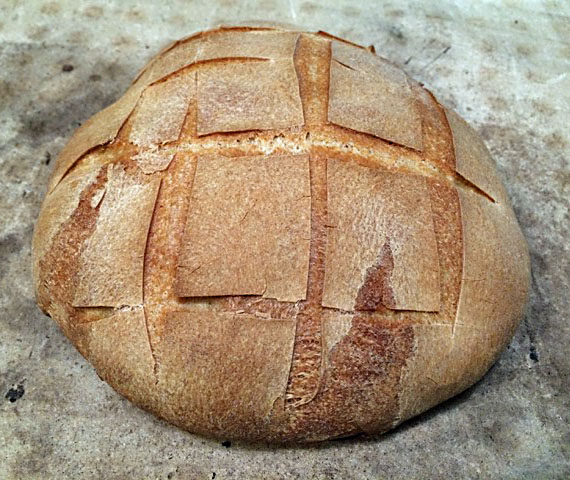
Trial #1 Loaf
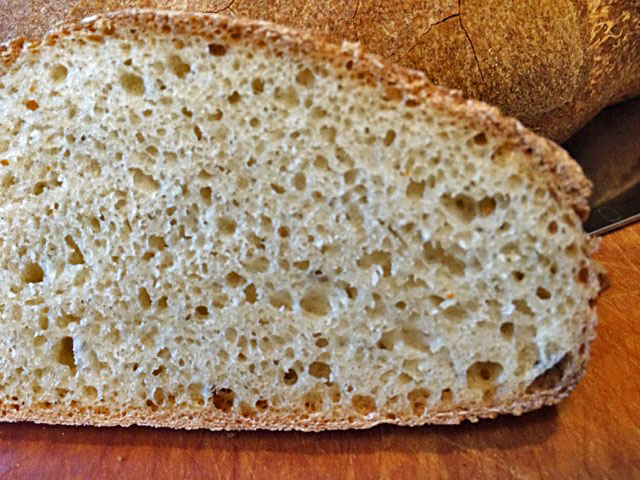
Trial #1 Crumb
Consistent with over-proofing, the crust was rather pale and dull. The oven spring was modest with relatively little bloom. The crust was a bit tough, not crunchy nor chewy. The crumb was surprisingly even. The flavor was good sourdough white bread – a little bit sweet with lactic acid flavors predominating and just a bit of acetic acid tang. Not bad bread but certainly not what I wanted to produce.
Trial bake #2
This second trial is my adaptation of slightly different procedure described in another journal article, the well-known 1970 Kline, Sugihara and McCready article with first documented the micro-flora population of San Francisco Sourdoughs. I used the same ingredients, changing the fermentation and proofing procedures.
Procedures
In the bowl of a stand mixer, add the water and flour and mix at Speed 1 to a shaggy mass. Cover and let rest at room temperature for 20-60 minutes. (Note: This autolyse step is my addition. It was not used in the original method.)
Sprinkle the salt over the dough and add the sponge in chunks. Mix at Speed 1 for 1 or 2 minutes until the ingredients are evenly distributed.
Mix at Speed 2 for 8-10 minutes, until an early window pane stage of gluten development.
Cover the mixer bowl and let the dough rest for 20 minutes at 80ºF.
Pre-shape as boule, put on a pie tin, place the tin in a plastic bag and let rest at room temperature for 30 minutes.
Shape as a boule and place in floured banneton. Place banneton in a plastic bag and seal.
The journal article says the bakery proofed for 6-8 hours at 85-90ºF. I proofed at 85ºF but found the loaf fully proofed after 5 hours. In hopes of enhancing acetic acid production, I chose to cold retard the loaf until the next day.
Pre-heat oven for 1 hour at 500ºF with baking stone and steaming apparatus in place.
Bake with steam at 460ºF for 15 minutes, then for another 25-30 minutes.
Remove to a rack and cool thoroughly before slicing.
Results
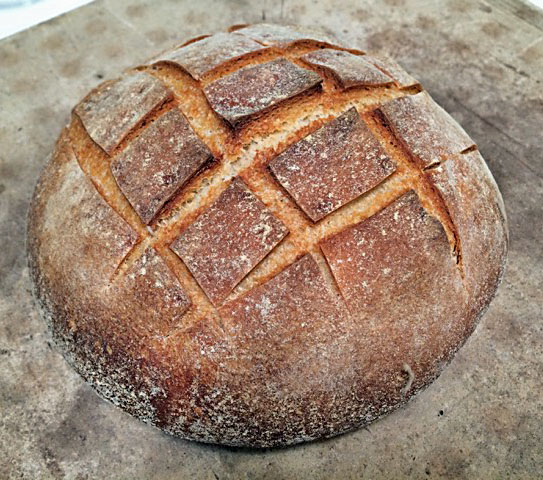
Trial #2 Loaf
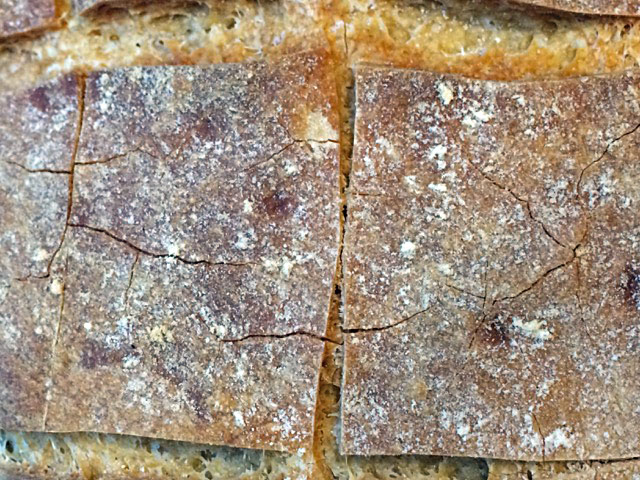
Trial #2 Crust (with crackles)
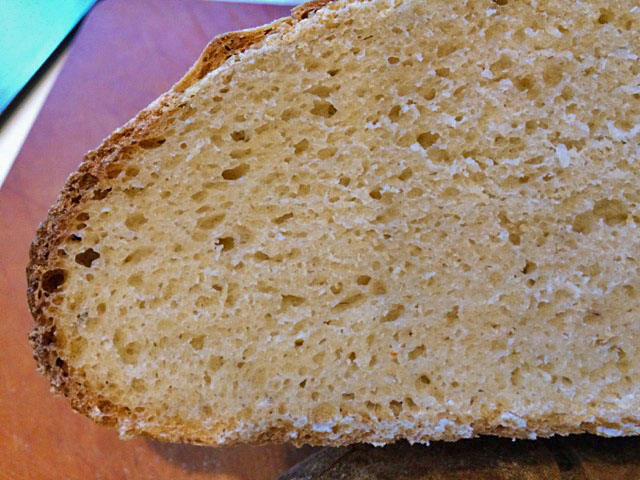
Trial #2 Crumb
The crust was darker than Trial bake #1. In fact, it was the color of the Parisian San Francisco Sourdough I remember. It is not as dark as the bread Boudin makes for Tadich Grill, which I would prefer. On slicing, the crumb is very compact, appropriate for a 60% hydration loaf. I have become so accustomed to breads made with higher hydration dough, this is startling. Nothing really wrong with it, just different.
The aroma of the cut bread is mild. It isn't particularly sour. It smells like nice sweet pain au levain. On tasting, the crust is satisfactorily crunchy. It is mildly nutty. As I said, I prefer a darker crust. The crumb is surprisingly tender with just a mild chewiness. It does not have the shredability of classic San Francisco Sourdough. I'm not sure how to achieve that. The flavor is predominantly sweet and buttery. There is a mild but “correct” sourdough tang. It has that special flavor, which is not merely a bigger slug of acetic acid, but is a combination of flavor tones from both acetic and lactic acids. This bread is weighted more on the lactic acid side than my personal ideal.
I am happy with Trial bake #2. Progress has been made, but there is more work to be done. I may increase the dough hydration a bit. I may fiddle with the fermentation temperature and the length of the cold retardation. At some point, I will surely add some whole grain flour. It may be that keeping the all white, high gluten flour firm starter going may improve the bread flavor over time. One can hope.
Any ideas or suggestions from the TFL community would be appreciated.
Happy baking!
David
- dmsnyder's Blog
- Log in or register to post comments
Having no knowledge of 'traditional' SF sourdough can't make any contribution but thought you might consult yourself in regard shredability ;-)) While your understandable preference is to avoid intensive mixing perhaps there will be a sweet spot which achieves the texture you seek without the flavour loss associated with intensive mixing........
http://www.thefreshloaf.com/node/22987/light-and-fluffy-100-whole-wheat-bread
Look forward to seeing results of any further trial bakes.
I may try longer mixing - maybe at lowest speed. I really don't want to over-mix mechanically. It's that elusive "sweet spot," as you say.
David
I think you loaves look great!!
What's the difference between lactic and acetic acid?
I'm looking forward to seeing the next versions of this loaf :)
Lactic acid is what gives yoghurt, buttermilk and sour cream their tartness. In bread, it comes across as creaminess, to me. Acetic acid is what is in vinegar. It's a much sharper sourness.
Although there are many subspecies of lactobacillus, they can be roughly divided into two groups. Some are "homofermentative." Those just produce lactic acid. The other group is "heterofermentative." Those can produce both lactic and acetic acid. Which is produced in higher proportion depends on the environment. In general, wet, warm dough favors lactic acid production. Dry, cold dough favors acetic acid production.
I believe the best tasting sourdough breads have a "balance" of flavors, and fermentation procedures determine that balance.
That's it in a nutshell. Hope it helps.
Happy baking!
David
To me, the hydration seems kind of low for such high water absorbing flour. I know you are going off of some old literature to get these numbers, but it still surprises me. I would think a little more water with a little more mixing would get you closer. But maybe it is just more mixing that is needed.
I actually have gotten the best results using all KAF Bread Flour. I love Central Milling flour for other things where it is more about bringing out the flavor of the flour than getting that correct balance needed for SF sourdough. Actually, my starter loved the Central Milling flour when I was using it. So maybe the sponge could use CM, and the bread flour use KAF Bread. Just a thought. Good luck, and I look forward to seeing how this works out.
Thanks for your comments!
You know, when you look at old, traditional bread recipes from most European countries, the hydration is typically 50-60%. Now, that's no doubt with lower protein flour than we use, but it's still dry. This high-hydration stuff (which I rather like) is a modern fashion, I think. Whatever, my next Trial bake will be at 70% hydration. I just finished developing the formula. It will also have 30% whole grain flours. The latter should absorb more water but also foster acetic acid production.
CM ABC flour will be used for the "bread flour." Compared to KAF AP, it makes for a more extensible dough, in my experience. Yet, I can't say I have remarked on any difference in the texture of the crumb. I ran out of KAF Bread Flour and will have to get some more for further testing. I guess, in the meantime, I could sub some high-gluten for ABC, but probably won't this time.
Thanks for your interest, and stay tuned.
David
Yeah, I know what you mean about the high hydration trend. I generally feel that somewhere in the mid-60% range is probably a good compromise. FWIW, one of the best SF Sourdoughs I have made used about 70% hydration and KAF bread flour (which is higher protein than I normally use). Throwing in whole grains is sure to absorb that extra water and also add to the acetic acid (haha... I just looked back at your comment and you said that same thing).
Waiting to see the results...
I'm a sucker for nostalgic things so I really enjoyed your adventure of recreating the bread so dear to your heart. SD microflora is also an interest for me and your techniques and documentation show that you are really a scientific baker.
And what trained palate you have! Able to discern the subtle nuances of the flavour profile whether it belongs to acetic or lactic acids.
I have a firm starter too and my loaves are sour but not sour enough for me (I think sour is subjective), it tastes closer to vinegar than yogurt so maybe it produces more acetic acid.
Thank you for this post and I can't wait for your next bakes of this bread.
It's always nice to hear from you!
David
Great experiment David. I have never had an authentic SF, SD so I have nothing to compare to as a benchmark. I look forward to part 3 of your experiment as that sounds like you will get closer to what you are looking for. I always find whole grains to add to the acetic acid production in my experiences.
Ian
David,
I really enjoy your posts when you have an experiment going on and you have specific goal that you are trying achieve! Thanks for sharing.
I've been meaning to do an experiment using the Tangzhong technique to get that shredability. Have you ever tried it?
Dwayne
I have never tried that technique. I have seen the term and know some TFL folks use it. I am not clear regarding its benefits.
David
the dough for that long, then you will want to up the hydration to say 65-68% to get the crumb open. To get the sour tang right you might want to do a cold retard and retard the levain for a day. Also baking at 450 F under steam and then turning down to 425 F should get crust the right color after leaving it in an off oven.
I have never understood the Larraburu method of 60 % Hydration, 425 F baking temperature and 105 F proofing and bulk ferment. In the late 60's and early 70s these bakeries had hearth ovens that weren't replaced till the 80's. I know the bakeries, even in cold SF were warm, but 105 F - with no proofers? I would think 80-85 F would be closer to reality. Maybe half AP and half bread flour would be better for the ctumb too?
I think your early 2012 attempt #2 with the cold retard was closest to color of the crust and crumb of the 1970 bread where you did less machine kneading here
http://www.thefreshloaf.com/node/26661/larraburu-two-variations-classic-san-francisco-sourdough
My closest attempt was here for color, crumb ab=nd taste but the SF bakeries weren't using 23% whole sprouted grains or retarded bran levain either but that was the only way I could get the acetic tang to come through like the old days. It might give you some ideas
http://www.thefreshloaf.com/node/41346/sprouted-sourdough-white-bread
These quests are fun but I wish we had better facts about what was really going on in the bakeries. There have to be a bunch of old bakers still around in the SF area .....from parisian,, columbo, toscana larrburu in those days that could be a better source. Maybe someone needs to have a reunion to talk with these folks about what was really going on. the kinds of flour, mixing, methods and temperatures. Pretty soon these people will all be gone before we know it - including us:-)
Happy questing
I really don't know about the equipment used in 1970's and earlier bakeries. They may well have had heated proofing cabinets, but not refrigerated rooms. Note that, in commercial baking, "cold retardation" means around 50 dF, not refrigerator temperatures of 40 dF. I assume the procedures documented in the scientific journals were accurate. Time and temperature are easy to replicate. Flour somewhat less so. Sourdough starter? Impossible really. So, we manipulate what is in our control, using what we know about how those variables effect flavor and hope for progressive approximation of our target characteristics.
I like your idea about interviewing any old-time SF bakers who are still around. I wonder if Michel Suas knows them.
David
bakeries were cranking out in the early 70's, I would have thought they would need a a very large room at 105 F to handle it all - not a cabinet. One thing is for sure is that in the late 40's early 50's they didn't have have heated cabinets and the bread had to be pretty similar to the late 60's and early 70's. I suppose they could could have had enough cabinets to hold a load for the oven and rotate the bread in and out of the cabinets for final proof only. I'm still guessing they made bread at what ever the ambient temperature was in the bakery. Some had the ovens in the basements and others had multiple floors where the temperature varied greatly from floor to floor depending on where the ovens were.
Maybe Suas and the other bakers of SF could get the word out to these old time bakers and have Josey Baker on Pizza Night or someone else, host a gathering for all of the them and have the rest of us there to get to know them and have then field some questions. Just an idea. There has to be quite a few of them out there about the same age as Vietnam Vets. It would be a fun night.
Some might be Fresh Lofians as well.
Nice write-up, David.
I'm not clear on your objective. Are you trying to replicate SFSD as closely as possible, or make a bread which is to your personal liking even if it's not an exact replica of the old-school breads?
If you're going to introduce whole-wheat flour then you're veering from the original recipe, so that has me a little confused. I've tried using ww in my SFSD baking and the result was unsatisfactory.
It would be interesting to talk to the person at Boudin who is in charge of the "Tadich bake", but I'm thinking that person is probably sworn to secrecy.
I know you're aware of the warmer proofing temperature used by Larraburu (105 F) vs the other bakeries. Are you going to try both?
Keep in mind that all of these bakeries had a production schedule to meet and had to get certain quantities out the door every day. I don't know that they had the time or refrigeration facilities to do overnight cold retards. In fact, I wonder if Larraburu's 4-hour proof at 105 F was implemented as a time-saving measure to hurry-up production. That the proofing times were around 8 hours makes me wonder if the bakery operated with three 8-hour shifts, which seems likely.
I have calculated the SFSD hydration to be about 59%. Keep in mind that the dough had to go through rounders and various other kinds of dough-handling machinery. This may account for the low hydration.
The baking brain at Larraburu after the brothers sold the bakery was a fellow named Richard Chamberlin, now deceased. He was also one of the three partners who owned it.
Here is an interesting glimpse inside Oakland's Toscana bakery from 1983. I think I found a mistake in the article! Can you find it?
https://news.google.com/newspapers?nid=1314&dat=19830907&id=gPhLAAAAIBAJ&sjid=p-4DAAAAIBAJ&pg=4495,2857323&hl=en
My objectives are first and foremost to capture the flavor as I remember it. As long as the texture is of reasonable quality, I'm satisfied. If I stray from the techniques of the legacy bakeries in the pursuit of flavor, I'm OK with that. For example, as an occasional baker I find a liquid starter easier to deal with than a stiff starter.
It would be interesting to talk to the person in charge of the "Tadich bake" at Boudin, but I'm thinking that person is probably sworn to secrecy.
Well, you have picked up on my ambivalence. I really want old-time SF Sourdough flavor but also the benefits of whole grain flours. I expect to conduct several more trials in this series (and eat too much bread in the process). I would like to end up with an all-white version and a 30-40% whole grain version.
I tried the higher proofing temperature in Trial #1, resulting in over-proofing and no good acetic acid production, and the lower (85 dF) proofing temperature in Trial #2 and 3. (As I recall.) I recognized that I changed other variables. Not good science, but it might get me to my desired result faster.
I'll take a look at the linked article sometime in the next few days. Life is interfering with baking experiments.
From what I have heard, the Tadich version of SF SD is indeed subject to a non-disclosure agreement.
David
In your listing of the ingredients in the final dough, should there be an entry for the starter/sponge, or did you omit it intentionally?
Sponge is in the Final Dough table. Look again. It is not in the Total Dough table. I have broken down the contents (water and high-protein flour) of the sponge in that table. See?
David
If it will help you focus your thinking, why don't you concentrate on doing one thing right, then when you've gone as far as you think you can with basic SFSD, start experimenting? That would mean holding off on the ww for the time being. WW flour isn't going away. It'll be around when you're ready for it.
Also, I can see where changing more than one variable at a time would confuse things.
The obvious question is, how did Larraburu pull off the 105 F proof without overproofing? I experimented with the 105 F proofing temp once recently. It didn't change the bread flavor much. The loaves developed a bit of a crust proofing at this temp. making it harder to score them.
forming when proofing - it is almost raining in there:-). You have to remember that David is quite an accomplished baker and has done several experiments over many years when it comes to replicating SFSD. Besides the one he is on now, he tried the Larraburu one above but another SFSD replica series of which I prefer his version 4 in that quest.
The problems I see with the Larraburu method is how do you get acetic tang without any cold in the method. Stiff you have in the starter, levain and even dough - but no cold. And 105 F should make the yeast nearly inactive since it falls off greatly after 94 F. Some LAB can produce CO2 just like yeast and in the same amounts with the right conditions, so you don't need yeast to be working to get a proof but you would get a lot of lactic acid - how do we know that these are the conditions that make lab act like yeast?. Over proofing can be handled by proofing for less time but then it does't natch the write up for time either.
I'm of the opinion that the method as written up is not right since it can't be replicated. I'm not sure that the hydration and baking temperatures are right either. The big question is why would Larraburu want its bread formula out in the public domain? I have tried it several times and it just doesn't work for crumb, color and taste - not even close but I am not alone either - no one has done it. But you can get very close to the real thing using other methods.
forming when proofing - it is almost raining in there:-). You have to remember that David is quite an accomplished baker and has done several experiments over many years when it comes to replicating SFSD. Besides the one he is on now, he tried the Larraburu one above but another SFSD replica series of which I prefer his version 4 in that quest.
The problems I see with the Larraburu method is how do you get acetic tang without any cold in the method. Stiff you have in the starter, levain and even dough - but no cold. And 105 F should make the yeast nearly inactive since it falls off greatly after 94 F. Some LAB can produce CO2 just like yeast and in the same amounts with the right conditions, so you don't need yeast to be working to get a proof but you would get a lot of lactic acid - how do we know that these are the conditions that make lab act like yeast?. Over proofing can be handled by proofing for less time but then it does't natch the write up for time either.
I'm of the opinion that the method as written up is not right since it can't be replicated. I'm not sure that the hydration and baking temperatures are right either. The big question is why would Larraburu want its bread formula out in the public domain? I have tried it several times and it just doesn't work for crumb, color and taste - not even close but I am not alone either - no one has done it. But you can get very close to the real thing using other methods.
There are two different recipes for S.F. SD, the main difference being the proofing time and temperature. Both recipes have a dough hydration of about 60%. The dough goes through various dough-handling machines; this may account for the relatively low hydration. It is then placed on canvas which wicks up some moisture. Both recipes bake at 400 F +/- 25 degrees. They may have pumped some live steam into the proofing chamber.
The sponge is refrigerated for at least 8 hours until the next refreshment.
Yeast doesn't die off until around 130 F. https://www.exploratorium.edu/cooking/bread/yeast_temp.html
If Larraburu didn't want to reveal its trade secrets they could have refused the USDA and others who wanted to study their process.
Yeast comes in many ways and tolerances. The high acid tolerant yeast found in SFSD cultures is quite different than commercial yeast. Here is Ganzel's data on the reproductive rates of the yeast found in some SFSD cultures. You can see the stress the yeast is under at 93 F. LAB love the heat but yeast not so much. The yeast may not die till later but they aren't doing much over 95 F.
Some type 2 LAB are used in fermenters in Europe at 122 F to make factory Rye Frankenbread. They have to let the mix cool way down before adding in the yeast so it can do its job in raising the loaf which it won't do at high temperatures. I like 92-93 F for making sour bread. The yeast is restricted so it takes longer to raise the loaf but the LAB's are making acid like crazy with more time to do so with the yeast being restricted.
The small amount of starter retarded won't make enough acetic acid for the dough total but retarding the levain and the dough will. Intensively mixed dough needs a lower hydration but 60% is very low even for that and those kinds of flour but it doesn't ever get the crumb right - but 65-68% hydration might. IF half the flour was AP it would work for sure. Intensively mixed dough doesn't give you the right crumb either. There is nothing about this process that makes any kind of sense to me and I have learned to never trust anything I read - especially if someone is giving away the trade secrets the business is based on. Boudin doesn't give theirs away today and I bet Larraburu didn't back then either. Happy baking
The 105 F 4-hour proof could have been a subterfuge so as not to reveal the complete Larraburu process, or it could be correct and they somehow had success with it. The reproductive rate slows down but it may still be able to raise bread.
When I tried proofing at 105 F I got a well-risen loaf with good flavor.
4 hours to make a loaf proof since the yeast is nearly inactive. All I know is that many people have tried to get this formula to work over many years and no on has succeeded yet. If it can't be repeated then something is very wrong with this formula and, in this case, there are likely several things wrong.
The other documented recipe proofs at 86 F. If someone can't get the Larraburu recipe to work, use the other one.
As I said, the 105 F, 4-hour proof gave me a lovely loaf.